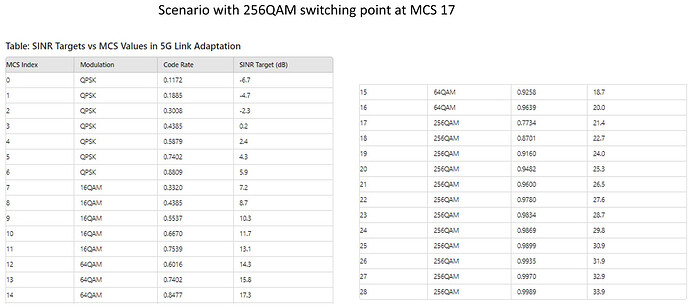The MCS selection and switching points really varies with SINR and different configurations.
The reason behind the variation in the starting MCS index for 256QAM observed in different drive test measurements is primarily due to differences in network configurations, equipment capabilities, and deployment scenarios.
Some comments/reasons follow:
-
Network Configuration and Policy
Operator Policy: Different mobile network operators may configure their networks differently based on their policies and the specific requirements of their customers. Some operators might enable 256QAM at lower MCS indices to maximize data rates in favorable conditions, while others might prefer to use higher MCS indices to ensure better reliability.
Adaptive Modulation and Coding (AMC): AMC is a technique used by base stations to dynamically select the most suitable MCS based on current radio conditions. The thresholds for switching between different modulation schemes, including 256QAM, can be configured differently by each operator. -
Radio Conditions
Signal Quality and Interference: In areas with excellent signal quality and minimal interference, 256QAM can be used effectively even at lower MCS indices. Conversely, in areas with poor signal quality or high interference, the network might restrict the use of 256QAM to higher MCS indices to maintain reliable communication.
SINR Variations: The Signal-to-Interference-plus-Noise Ratio (SINR) is a key determinant for the use of higher-order modulations like 256QAM. Variations in SINR across different locations can lead to different starting points for 256QAM usage. -
Equipment Capabilities
User Equipment (UE): The capabilities of the user devices can influence the MCS index at which 256QAM is supported. More advanced devices with better receivers and antennas might support 256QAM at lower MCS indices.
Base Station Capabilities: The capabilities of the base station hardware and software can also affect the MCS thresholds. More advanced base stations might have better processing power and algorithms to handle higher-order modulations more effectively. -
Deployment Scenarios
Urban vs. Rural Areas: In dense urban environments with high signal quality and more closely spaced base stations, 256QAM might be used at lower MCS indices. In rural or less dense areas, higher MCS indices might be required for 256QAM due to larger cell sizes and potentially poorer signal quality.
Network Load: High network load and congestion can also influence the modulation schemes used. In heavily loaded networks, higher MCS indices might be used to maintain service quality.
LinkedIn: ![]()


